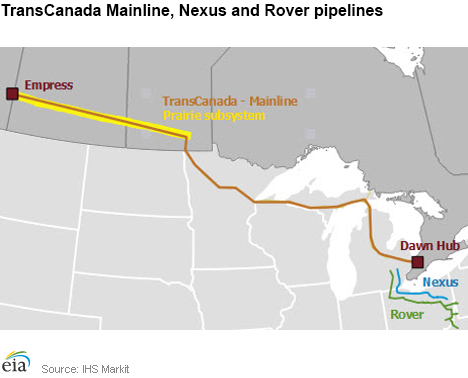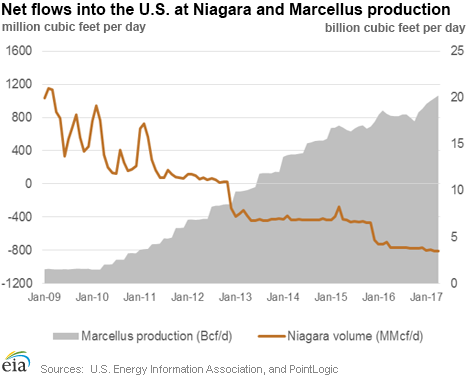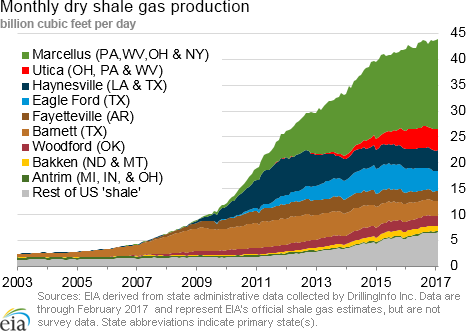In the News:
TransCanada reduces and simplifies toll rates to remain competitive
On March 13, TransCanada concluded new contracting rounds—referred to as a binding open season—for its Mainline pipeline, which connects gas producers in Western Alberta to Eastern Canada. Specifically, the open season was for firm pipeline capacity going from TransCanada's Empress receipt point in Alberta to the Dawn market in Ontario. The Dawn market includes a 160 billion cubic foot deliverability storage complex that serves customers throughout North America.
The new term stipulates a flat rate of Canadian Dollar 77¢ per gigajoule (US 61¢ per million British thermal units (MMBtu)), and applies to customers irrespective of the volume of gas shipped. From 2015-16, comparable toll rates averaged US $1.41/MMBtu. During open season last November, TransCanada offered lower rates for more volume flows as an incentive for higher gas throughput in the Mainline. However, the level of interest fell short of the minimum needed to support that service, according to TransCanada, and that proposal was suspended.
TransCanada's reevaluation of its toll rate under longer-term contracts occurred with increasing levels of production from the Marcellus shale play and proposed pipeline projects that will move Marcellus gas north (e.g., Rover and Nexus pipelines). A Canada National Energy Board (NEB) 2014 Energy Market Assessment report cited rising Marcellus production as an important factor in declining capacity utilization on TransCanada's Mainline. Average monthly Marcellus production has increased by over 105% from January 2013 to March 2017. Thus far, Marcellus production has been growing faster than available pipeline capacity in the region. New pipelines are expected to alleviate some of the bottlenecks.
According to NEB, in 2015, capacity utilization on the TransCanada mainline Prairie section averaged 43%. In addition, the Mainline pipeline's Niagara Falls, New York, border crossing, where natural gas transits from Ontario, Canada, to New York, has been experiencing reduced flows over the past 7 years, according to data from PointLogic. In 2012, imports into the United States from the Niagara Falls border crossing were reduced dramatically and reversed direction, and gas now flows from the United States to Canada on a net basis.
Long-term contracts resulting from TransCanada's latest open season can enter into place as early as November 1, 2017, pending approval by the NEB.
Overview:
(For the Week Ending Wednesday, March 22, 2017)
- Natural gas spot price movements were mixed this report week (Wednesday, March 15 to Wednesday, March 22), but they fell sharply in the Northeast. The Henry Hub spot price fell slightly from $3.00/MMBtu last Wednesday to $2.98/MMBtu yesterday.
- At the New York Mercantile Exchange (Nymex), the April 2017 contract price rose 3¢ from $2.981/MMBtu last Wednesday to $3.011/MMBtu yesterday.
- Net withdrawals from working gas totaled 150 billion cubic feet (Bcf) for the week ending March 17. Working natural gas stocks are 2,092 Bcf, which is 16% less than the year-ago level but 15% greater than the five-year (2012–16) average for this week.
- The natural gas plant liquids (NGPL) composite price at Mont Belvieu, Texas, fell by 33¢, averaging $5.88/MMBtu for the week ending March 22. The prices of ethane, propane, butane, and isobutane fell by 5%, 8%, 7%, and 6%, respectively. The price of natural gasoline rose by 1%. To better align with the with natural gas spot prices in this report, NGPL prices now represent averages covering Thursday last week to Wednesday this week (yesterday). Previously, these prices were an average of Monday through Friday prices from the previous week.
- According to Baker Hughes, for the week ending Friday, March 17, the natural gas rig count increased by 6 to 157. The number of oil-directed rigs rose by 14 to 631. The total rig count increased by 21, and it now stands at 789.
Prices/Supply/Demand:
Prices mixed. This report week (Wednesday, March 15 to Wednesday, March 22), the Henry Hub spot price fell 2¢ from $3.00/MMBtu last Wednesday to $2.98/MMBtu yesterday. Last report week, the eastern half of the country was affected by unseasonably cold temperatures and a late-winter snowstorm, pushing up prices in the Northeast and Midwest. As temperatures moderated during the current report week, prices generally fell. At the Chicago Citygate, prices decreased 4¢ from $2.93/MMBtu last Wednesday to $2.89/MMBtu yesterday.
The price at PG&E Citygate in Northern California gained 4¢ to $3.19/MMBtu yesterday. The price at SoCal Citygate rose 14¢ from $2.93/MMBtu last Wednesday to $3.07/MMBtu yesterday. Temperatures in California fell over the weekend, pushing the price up 25¢ between Friday and Monday. Additionally, the Aliso Canyon natural gas storage field is not available for full storage service. EIA publishes information about Southern California natural gas and energy prices in the Southern California Daily Energy Report.
Northeast prices fall sharply. Coming off of a late-winter snowstorm and unseasonably cold weather last week, prices in the Northeast fell sharply. At the Algonquin Citygate, which serves Boston-area consumers, prices went down $3.44 from $7.45/MMBtu last Wednesday to $4.01/MMBtu yesterday. At the Transcontinental Pipeline Zone 6 trading point for New York, prices decreased $3.71 from $6.82/MMBtu last Wednesday to $3.11/MMBtu yesterday.
Marcellus prices were largely unaffected by the moderating weather. Tennessee Zone 4 Marcellus spot prices were constant week over week at $2.77/MMBtu. Prices at Dominion South in northwest Pennsylvania fell 3¢ to $2.82/MMBtu yesterday.
April Nymex contract up slightly. At the Nymex, the price of the April 2017 contract increased 3¢, from $2.981/MMBtu last Wednesday to $3.011/MMBtu yesterday. The price of the 12-month strip, which averages the April 2017 through March 2018 futures contracts, climbed 5¢ to $3.258/MMBtu.
Supply falls slightly. According to data from PointLogic, the average total supply of natural gas fell by 1% compared with the previous week. While dry natural gas production remained constant week over week, average net imports from Canada decreased by 4% from last week.
Demand falls significantly. Total U.S. consumption of natural gas fell by 15% compared with the previous report week, according to data from PointLogic. Last week's weather featured unusually cold weather and a snowstorm in the Northeast, which pushed demand up. This week, weather moderated across most of the country, pushing demand down. Week over week, power burn declined by 9%; industrial sector consumption decreased by 5%; and residential/commercial sector consumption declined by 26%. Natural gas exports to Mexico decreased 2%.
U.S. liquefied natural gas (LNG) exports. Natural gas pipeline deliveries to the Sabine Pass liquefaction terminal averaged 2.2 Bcf/d for the report week, 8% higher than the previous week. Four vessels (combined LNG-carrying capacity of 13.9 Bcf) departed Sabine Pass last week, and one vessel (LNG-carrying capacity of 3.8 Bcf) is currently loading at the terminal.
Last week, Cheniere Energy, the operator of the Sabine Pass terminal, received authorization from the Federal Energy Regulatory Commission (FERC) to commence liquefaction and export activities from Train 3. On March 16, Cheniere filed a request with FERC to begin commissioning of Train 4. Once the fourth train at Sabine Pass becomes operational, the total baseload nameplate capacity of the facility (including all four trains) will reach 2.6 Bcf/d, with a maximum operating capacity of 2.9 Bcf/d. The fifth train at the facility, currently under construction, is expected to begin service in mid-2019.
Storage:
Late winter blast of cold weather during the storage week results in larger withdrawals from working gas storage. Net withdrawals from storage totaled 150 Bcf, compared with the five-year (2012–16) average net withdrawal of 21 Bcf and last year's net injections of 13 Bcf during the same week. Cold temperatures and wintry conditions throughout the week for most of the Lower 48 states east of the Rockies contributed to increased heating demand for natural gas compared with normal levels, leading to larger withdrawals from storage. Working gas stocks totaled 2,092 Bcf, which is 266 Bcf more than the five-year average and 399 Bcf less than last year at this time.
Working gas levels fall relative to the five-year average for the first time in five weeks. All regions in the Lower 48 states, except for the Pacific and Mountain region, posted declines against their five-year averages for the week. In the South Central region, the surplus relative to the five-year average totaled 114 Bcf at salt facilities, and 92 Bcf at nonsalt facilities, down from the previous week's level of 152 Bcf and 106 Bcf, respectively. The Midwest region has a surplus of 109 Bcf.
Working gas stocks remain on pace to end the 2016–17 heating season above 2,000 Bcf. If working gas stock changes follow the five-year average for the remainder of the heating season, they will total 2,052 Bcf on March 31. So far in 2017, net withdrawals are 19% below the five-year average. Working gas levels topped this threshold at the end of the heating season only two other times, in 2012 and 2016, when working gas totaled 2,473 Bcf and 2,470 Bcf, respectively. Both of those heating seasons were also characterized by warmer-than-normal temperatures and relatively light heating demand for natural gas.
Withdrawals are close to market expectations for the week. According to the Bloomberg survey of natural gas analysts, estimates of net withdrawals from natural gas storage ranged from 140 Bcf to 164 Bcf, with a median withdrawal of 151 Bcf. The price of the Nymex futures contract for April 2017 delivery at Henry Hub decreased 2¢/MMBtu to $2.91/MMBtu in 302 trades at the release of the Weekly Natural Gas Storage Report (WNGSR). Prices varied and rebounded in subsequent trading, reaching $2.91/MMBtu within two hours of the WNGSR release.
Temperatures are lower than normal throughout most of the Lower 48 states during the storage report week. Temperatures in the Lower 48 states averaged 39°F, 5°F lower than the normal and 16°F lower than last year at this time. The colder-than-normal temperatures prevailed throughout most of the Lower 48 states, east of the Rockies. In particular, temperatures were considerably colder than normal in areas of the Lower 48 states where natural gas is an important fuel source for space heating. Temperatures in the New England Census division averaged 23°F, 12°F lower than the normal and 25°F lower than last year at this time. Temperatures in the Middle Atlantic Census division averaged 25°F, 12°F lower than the normal and 26°F lower than last year at this time. Temperatures in the East North Central Census division averaged 25°F, 11°F lower than the normal and 26°F lower than last year at this time. Temperatures in the West North Central Census division averaged 26°F, 10°F lower than the normal and 25°F lower than last year at this time.
See also:
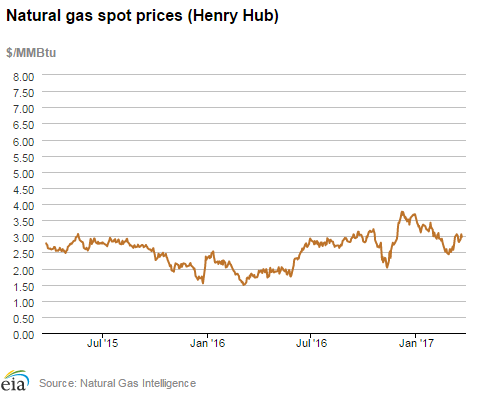
| Spot Prices ($/MMBtu) | Thu, 16-Mar |
Fri, 17-Mar |
Mon, 20-Mar |
Tue, 21-Mar |
Wed, 22-Mar |
|---|---|---|---|---|---|
| Henry Hub |
2.85 |
2.82 |
2.92 |
3.06 |
2.98 |
| New York |
3.23 |
3.04 |
2.97 |
3.36 |
3.11 |
| Chicago |
2.77 |
2.76 |
2.89 |
2.99 |
2.89 |
| Cal. Comp. Avg.* |
2.70 |
2.70 |
2.83 |
2.92 |
2.85 |
| Futures ($/MMBtu) | |||||
| April contract | 2.902 |
2.948 |
3.041 |
3.093 |
3.011 |
| May Contract |
2.967 |
3.004 |
3.098 |
3.155 |
3.073 |
| *Avg. of NGI's reported prices for: Malin, PG&E Citygate, and Southern California Border Avg. | |||||
| Source: NGI's Daily Gas Price Index | |||||
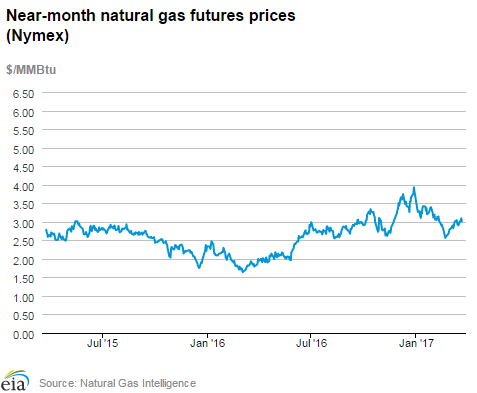
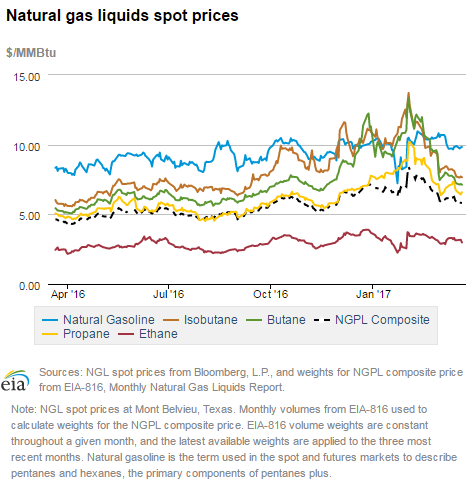
| U.S. natural gas supply - Gas Week: (3/16/17 - 3/22/17) | |||
|---|---|---|---|
Average daily values (Bcf/d): |
|||
this week |
last week |
last year |
|
| Marketed production | 78.7 |
79.0 |
81.7 |
| Dry production | 70.2 |
70.5 |
73.2 |
| Net Canada imports | 5.9 |
6.2 |
5.2 |
| LNG pipeline deliveries | 0.0 |
0.1 |
0.2 |
| Total supply | 76.2 |
76.7 |
78.7 |
|
Source: OPIS PointLogic Energy, an IHS Company | |||
| U.S. natural gas consumption - Gas Week: (3/16/17 - 3/22/17) | |||
|---|---|---|---|
Average daily values (Bcf/d): |
|||
this week |
last week |
last year |
|
| U.S. consumption | 70.8 |
83.7 |
71.3 |
| Power | 22.2 |
24.4 |
25.0 |
| Industrial | 21.5 |
22.6 |
21.3 |
| Residential/commercial | 27.1 |
36.7 |
25.0 |
| Mexico exports | 3.8 |
3.9 |
3.3 |
| Pipeline fuel use/losses | 6.2 |
7.4 |
6.3 |
| LNG pipeline receipts | 2.2 |
2.0 |
0.6 |
| Total demand | 83.0 |
96.9 |
81.4 |
|
Source: OPIS PointLogic Energy, an IHS Company | |||
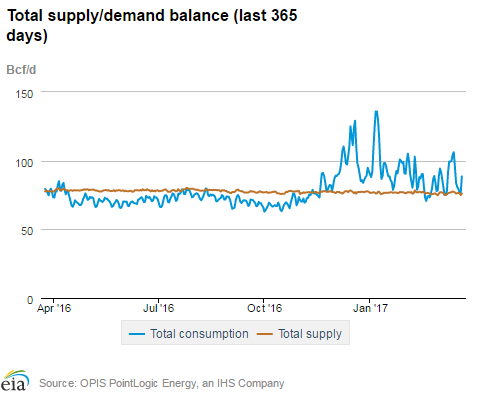
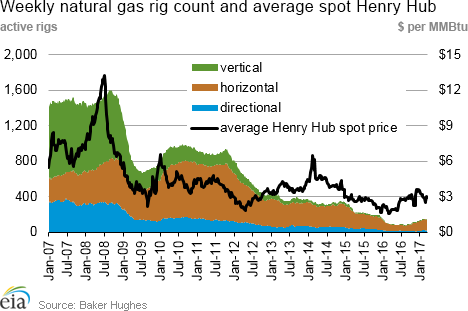
| Rigs | |||
|---|---|---|---|
Fri, March 17, 2017 |
Change from |
||
last week |
last year |
||
| Oil rigs | 631 |
2.3% |
63.0% |
| Natural gas rigs | 157 |
4.0% |
76.4% |
| Note: Excludes any miscellaneous rigs | |||
| Rig numbers by type | |||
|---|---|---|---|
Fri, March 17, 2017 |
Change from |
||
last week |
last year |
||
| Vertical | 70 |
2.9% |
20.7% |
| Horizontal | 658 |
3.0% |
78.3% |
| Directional | 61 |
0.0% |
24.5% |
| Source: Baker Hughes Inc. | |||
| Working gas in underground storage | ||||
|---|---|---|---|---|
Stocks billion cubic feet (Bcf) |
||||
| Region | 2017-03-17 |
2017-03-10 |
change |
|
| East | 309 |
368 |
-59 |
|
| Midwest | 506 |
557 |
-51 |
|
| Mountain | 137 |
137 |
0 |
|
| Pacific | 208 |
203 |
5 |
|
| South Central | 932 |
977 |
-45 |
|
| Total | 2,092 |
2,242 |
-150 |
|
| Source: U.S. Energy Information Administration | ||||
| Working gas in underground storage | |||||
|---|---|---|---|---|---|
Historical comparisons |
|||||
Year ago (3/17/16) |
5-year average (2012-2016) |
||||
| Region | Stocks (Bcf) |
% change |
Stocks (Bcf) |
% change |
|
| East | 453 |
-31.8 |
355 |
-13.0 |
|
| Midwest | 572 |
-11.5 |
397 |
27.5 |
|
| Mountain | 148 |
-7.4 |
123 |
11.4 |
|
| Pacific | 260 |
-20.0 |
226 |
-8.0 |
|
| South Central | 1,058 |
-11.9 |
725 |
28.6 |
|
| Total | 2,491 |
-16.0 |
1,826 |
14.6 |
|
| Source: U.S. Energy Information Administration | |||||
| Temperature – heating & cooling degree days (week ending Mar 16) | ||||||||
|---|---|---|---|---|---|---|---|---|
HDD deviation from: |
CDD deviation from: |
|||||||
| Region | HDD Current |
normal |
last year |
CDD Current |
normal |
last year |
||
| New England | 292 |
85 |
177 |
0 |
0 |
0 |
||
| Middle Atlantic | 278 |
85 |
183 |
0 |
0 |
0 |
||
| E N Central | 280 |
77 |
180 |
0 |
0 |
0 |
||
| W N Central | 276 |
73 |
173 |
0 |
-1 |
0 |
||
| South Atlantic | 179 |
63 |
148 |
8 |
-3 |
-19 |
||
| E S Central | 174 |
64 |
152 |
0 |
-4 |
-10 |
||
| W S Central | 76 |
9 |
52 |
8 |
-3 |
-16 |
||
| Mountain | 93 |
-68 |
-26 |
10 |
9 |
8 |
||
| Pacific | 28 |
-63 |
-56 |
0 |
-1 |
0 |
||
| United States | 187 |
35 |
107 |
3 |
-1 |
-5 |
||
|
Note: HDD = heating degree day; CDD = cooling degree day Source: National Oceanic and Atmospheric Administration | ||||||||
Average temperature (°F)
7-Day Mean ending Mar 16, 2017
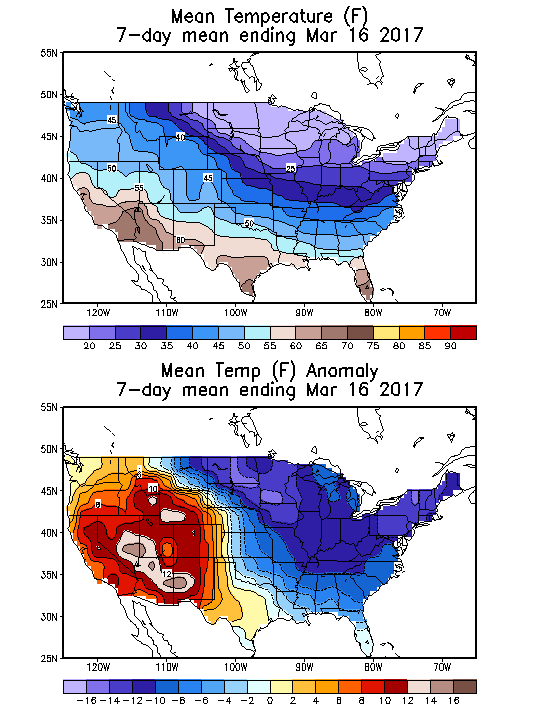
Source: NOAA National Weather Service
Deviation between average and normal (°F)
7-Day Mean ending Mar 16, 2017

Source: NOAA National Weather Service

